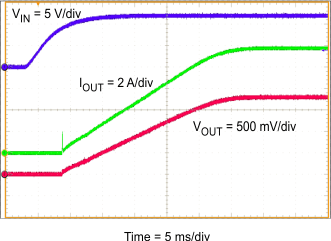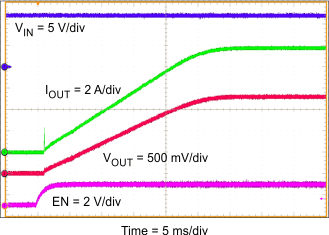SLVU777A September 2012 – November 2021 TPS54020
2.9 Start Up
Figure 2-8 and Figure 2-9 show the start-up waveforms for the EVM. In Figure 2-8, the output voltage ramps up as soon as the input voltage reaches the UVLO threshold as set by the R6 and R11 resistor divider network. In Figure 2-9, the input voltage is initially applied and the output is inhibited by using a jumper at J5 to tie EN to GND. When the jumper is removed, EN is released. When the EN voltage reaches the enable threshold voltage, the start-up sequence begins and the output voltage ramps up to the externally set value of 1.8 V. The input voltage for these plots is 12 V and the load is 10-A resistive load.
 Figure 2-8 TPS54020EVM-082 Start Up with VIN
Figure 2-8 TPS54020EVM-082 Start Up with VIN Figure 2-9 TPS54020EVM-082 Start Up with EN
Figure 2-9 TPS54020EVM-082 Start Up with EN